Low and slow cooking is the perfect way to produce a meltingly tender corned beef dinner that will have your St. Patrick’s Day guests wanting seconds. This recipe for Slow Cooker Corned Beef and Cabbage with carrots and potatoes uses a beer-infused cooking liquid for juicy meat with incredible flavor.
Want to browse other corned beef cooking methods? Check out my reader-favorite recipes for Beer Braised Corned Beef with Whiskey Mustard Glaze (Dutch oven), or Instant Pot Corned Beef and Cabbage (Electric Pressure Cooker).
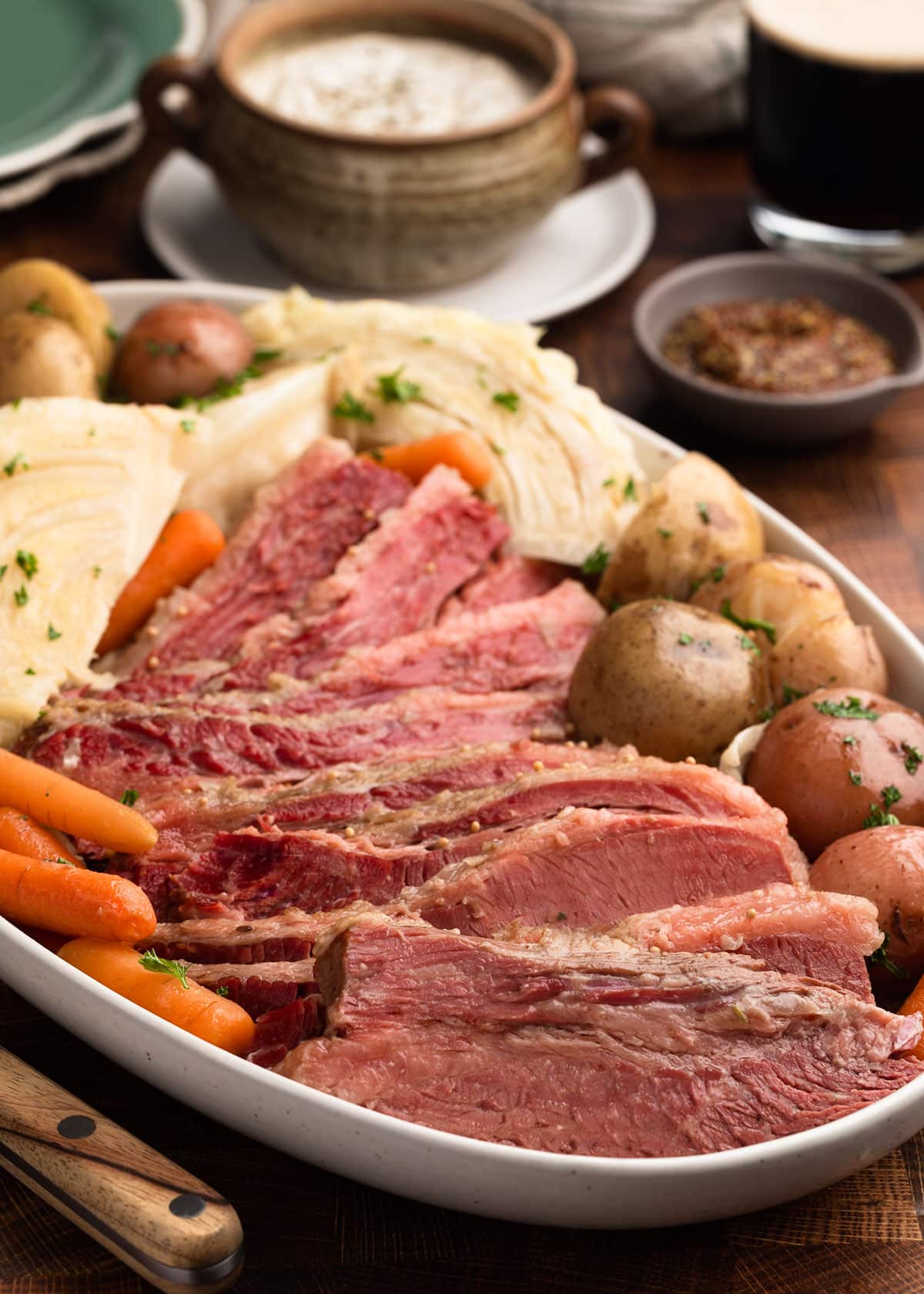
Before You Start Cooking
- This Slow Cooker Corned Beef and Cabbage recipe is incredibly easy, with just 10 minutes of prep before the slow cooker takes over. Aside from two quick steps to add the vegetables, it’s a set-it-and-forget-it meal.
- Since this recipe includes corned beef, potatoes, carrots, and cabbage, I recommend using a large (6- to 7-quart) slow cooker so everything fits comfortably.
- Plan on 8 to 10 hours of cooking on low heat. While some recipes suggest cooking corned beef on high, I don’t recommend it—higher temperatures can make the brisket tough. A slow, gentle cook ensures tender, flavorful meat.
How to Make Slow Cooker Corned Beef
For this recipe, you’ll need a“flat cut” corned beef brisket weighing 4 to 5-1/2 pounds. Be sure it has a nice fat cap for the best flavor.
Before cooking corned beef, I always recommend rinsing it well under cool water to remove any residual brine. This will help ensure that your cooked brisket isn’t too salty.
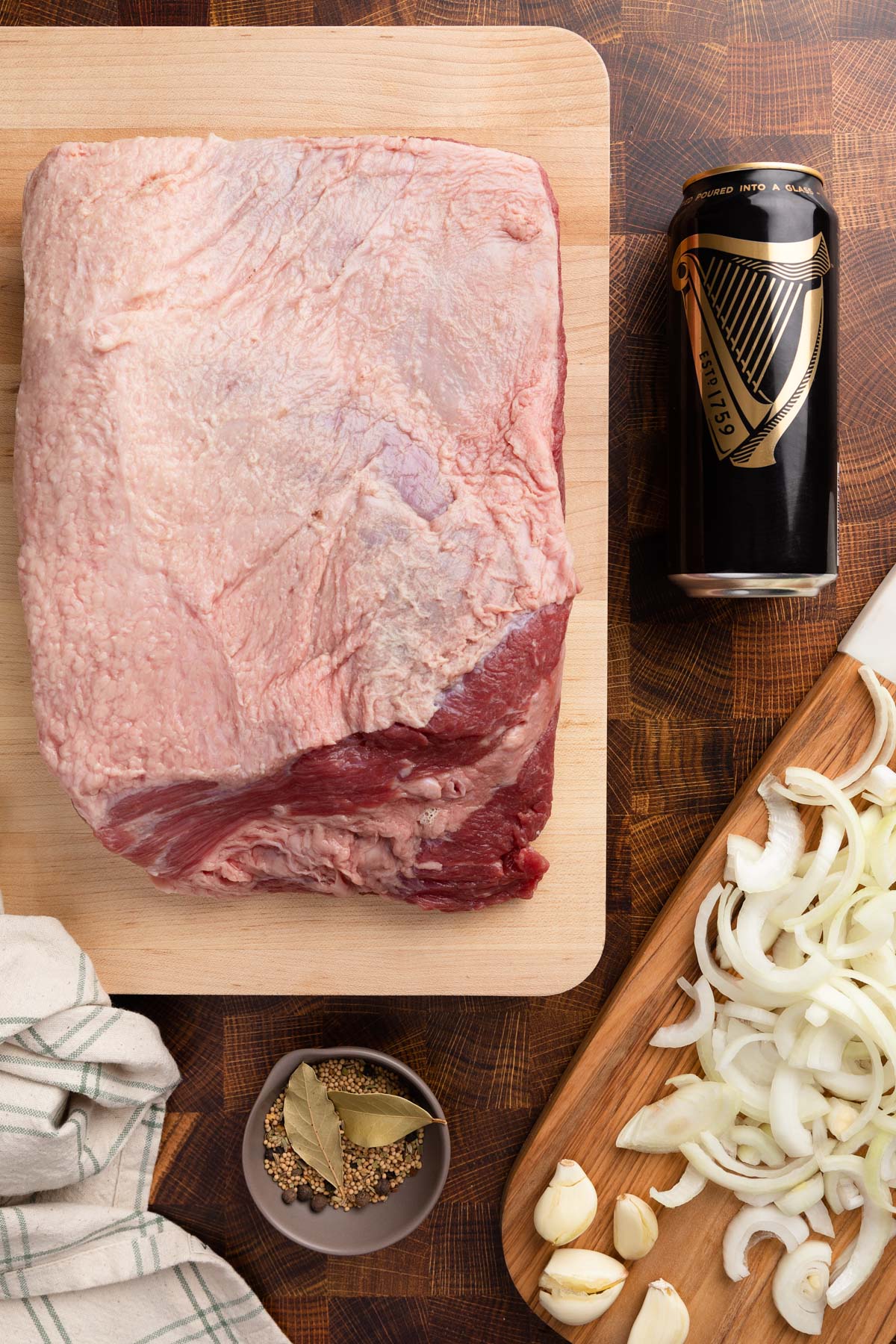
Step 1. Layer the Ingredients in the Slow Cooker
Start by making a base layer in your slow cooker with sliced yellow onions and whole garlic cloves, peeled and smashed. Sprinkle half of the seasoning packet that comes with your corned beef (or about 1 tablespoon of pickling spices if your brisket doesn’t include one) evenly over the onions.
Place the rinsed corned beef on top, fat cap facing up. Sprinkle the remaining seasoning packet or pickling spices over the brisket, and add a dried bay leaf (or two, if they’re small).
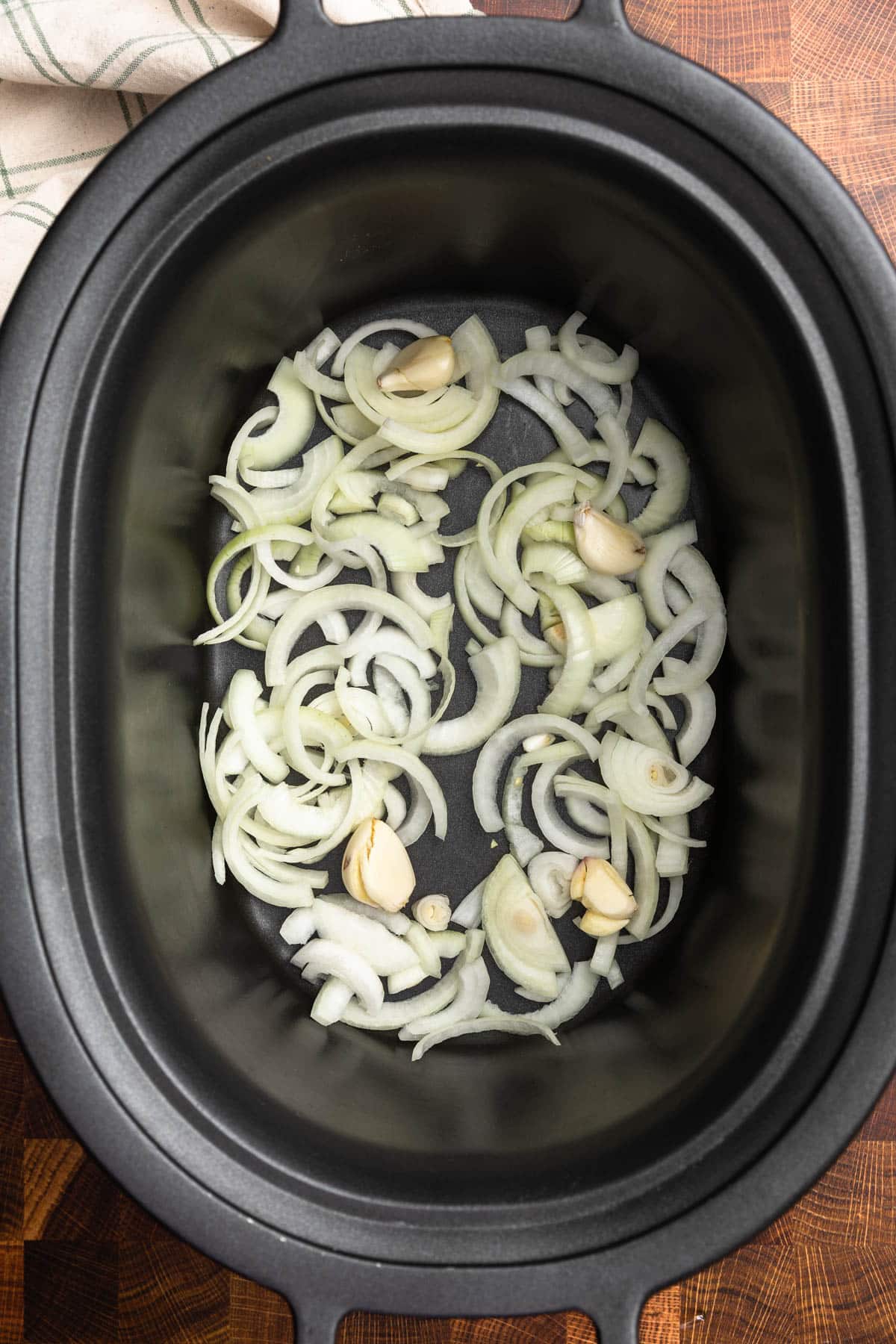
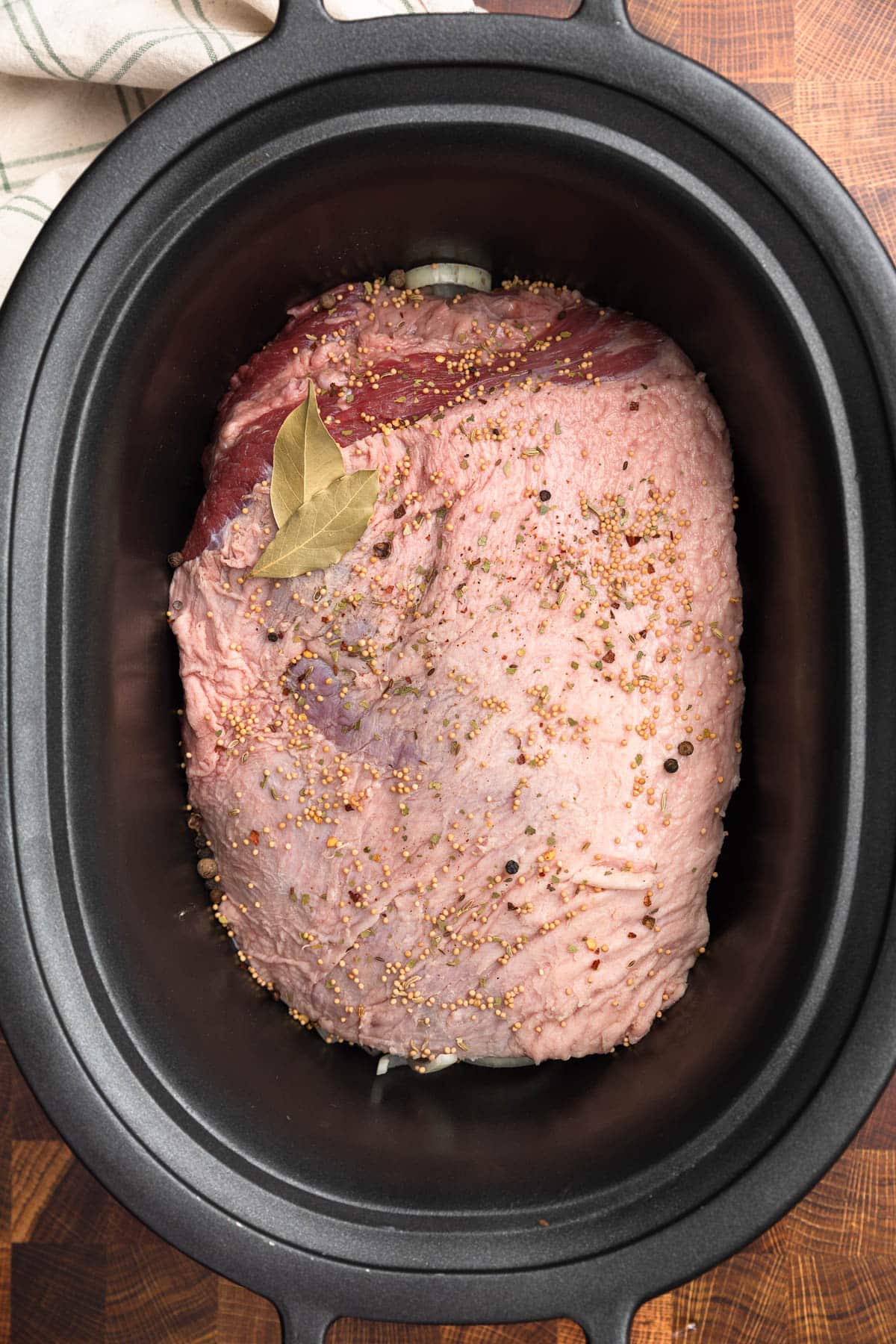
Pour 1 cup of beer over the brisket, then add enough cool water to just cover the meat. The exact amount of water you need will vary based on the size and shape of your brisket—expect to use between 2 and 4 cups. (The 5-1/2 pound brisket shown here needed about 4 cups of water.)
If your brisket has an irregular shape, it’s fine if a little fat peeks out from the top. Just make sure all the meat is fully submerged.
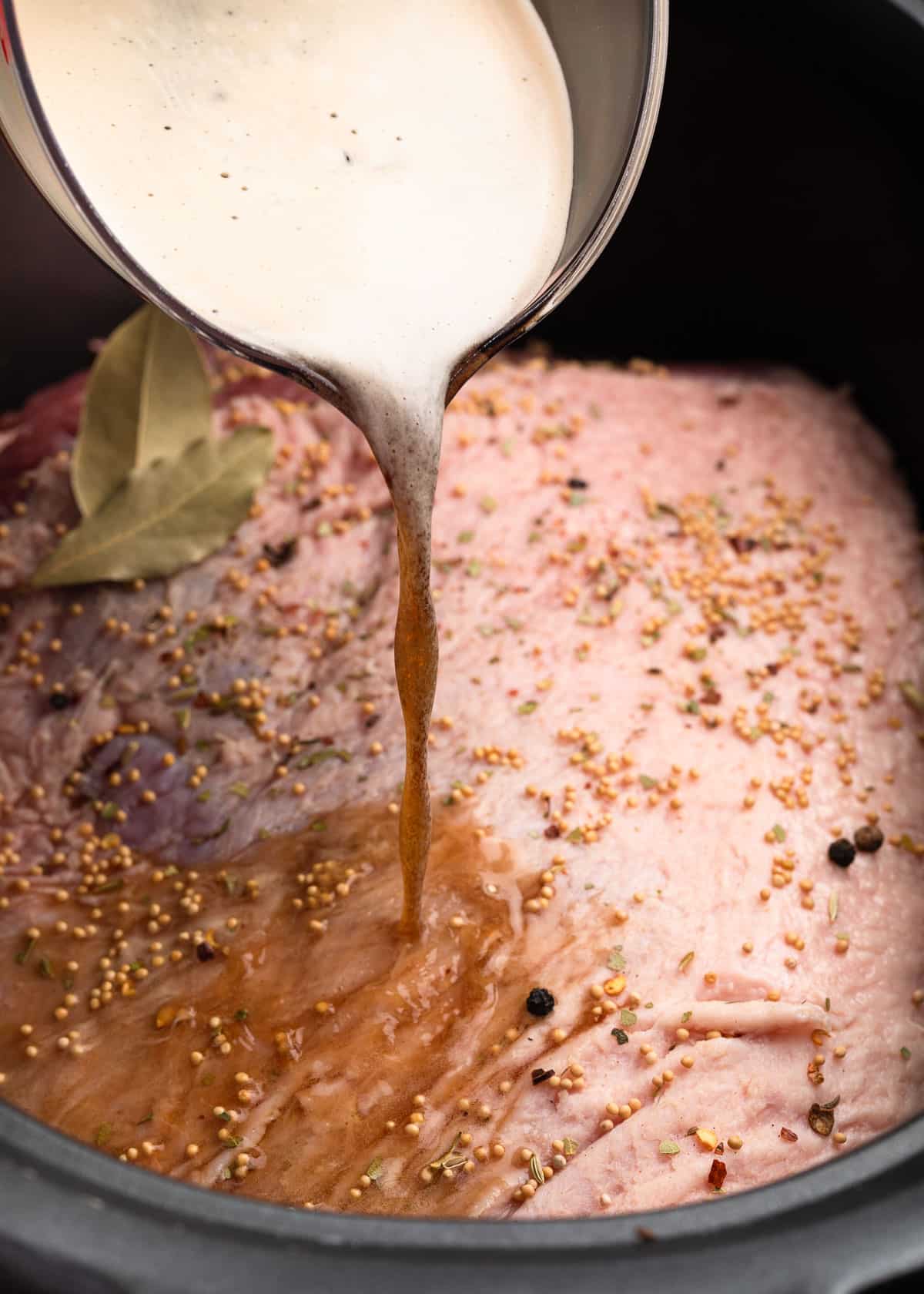
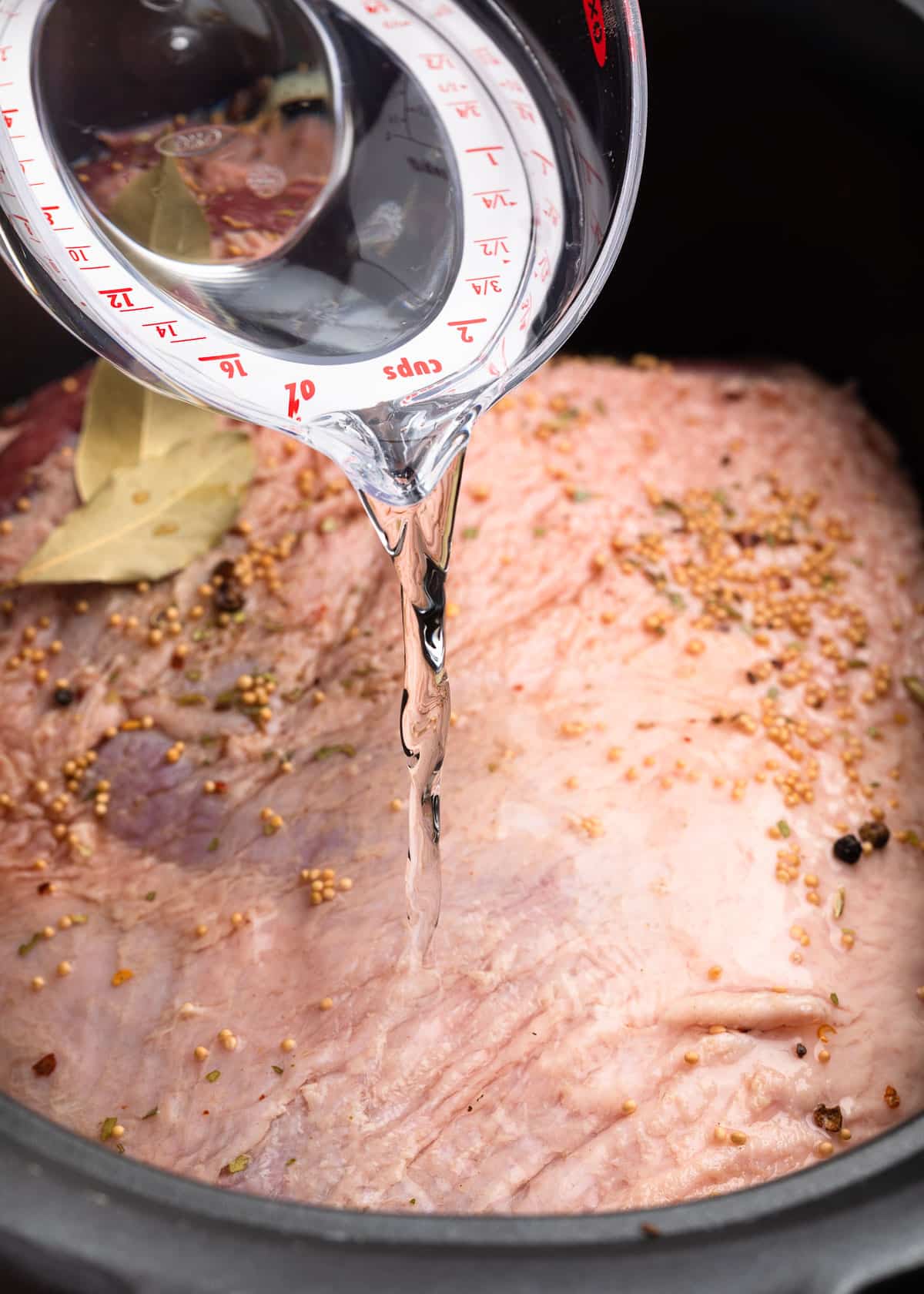
Tip: Beer adds great flavor to the cooking liquid and helps to tenderize the corned beef, but be mindful not to choose anything too hoppy or bitter.
If using stout, I recommend Guinness Draught (less bitter than “Extra Stout”) or Murphy’s Irish Stout. For a more subtle flavor, a lager-style beer works well—our favorite for corned beef is Samuel Smith Pure Brewed Organic Lager.
Want to skip the beer? Use unsalted beef broth or stock instead.
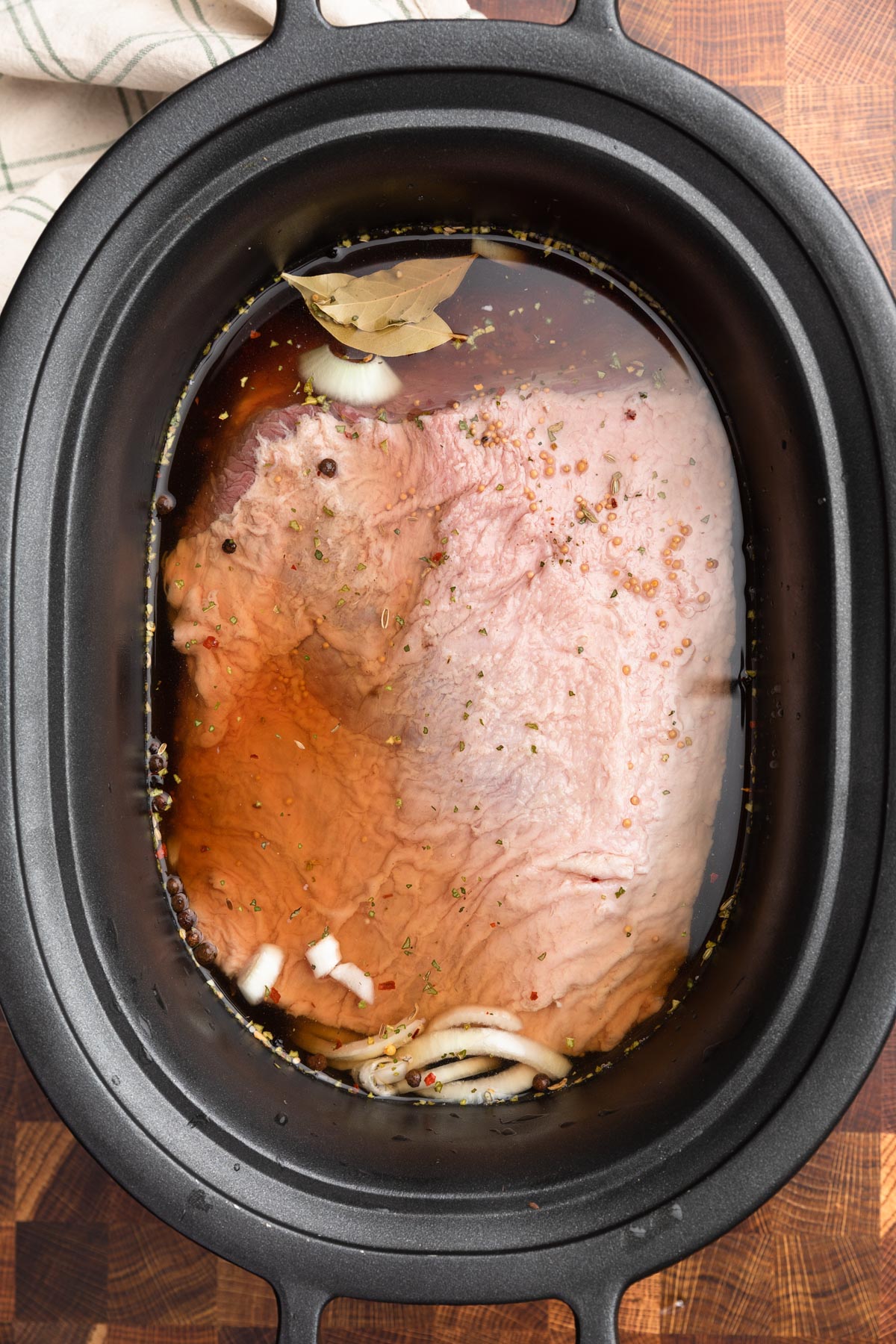
Step 2: Cook the Corned Beef
At this point, the recipe becomes mostly hands-off. Cover your slow cooker and set it to LOW for 8-10 hours, depending on the size of the corned beef and the cooked texture you prefer.
We like our corned beef to be tender but still sliceable. For the 5-1/2 pound corned beef pictured, 9 hours on LOW was the sweet spot.
If you like your corned beef to have more of a fall-apart, shredded consistency, go for the full 10 hours. If you’re cooking a corned beef closer to 4 pounds, check it at the 8 hour mark.
When the corned beef is ready, you’ll be able to slide a fork in and out of the brisket without resistance.

Step 3: Add the Potatoes and Carrots
I like to make this a one-pot corned beef dinner with vegetables, but I find that if you add them at the start of the cooking time, they’ll be quite overcooked and mushy by the end of the 8-10 hours.
After the corned beef has been cooking for about 3 hours, add in:
- Potatoes. I use baby red and/or golden potatoes, 1-1/2 to 2 inches in diameter. Since these varieties are thin-skinned, there’s no need to peel. If using larger potatoes, cut them into 1-1/2 to 2 inch chunks.
- Carrots. Use a bag of baby-cut carrots for convenience, or 4-5 large carrots cut into 2-inch lengths.
Since we’re cooking on LOW, the potatoes and carrots will need to cook for 5-6 hours for a soft, fork-tender texture. Nestle them around the brisket, submerging them in the flavorful cooking liquid where possible.
Place the lid back on the slow cooker and let it cook for a few more hours, until adding the cabbage wedges.
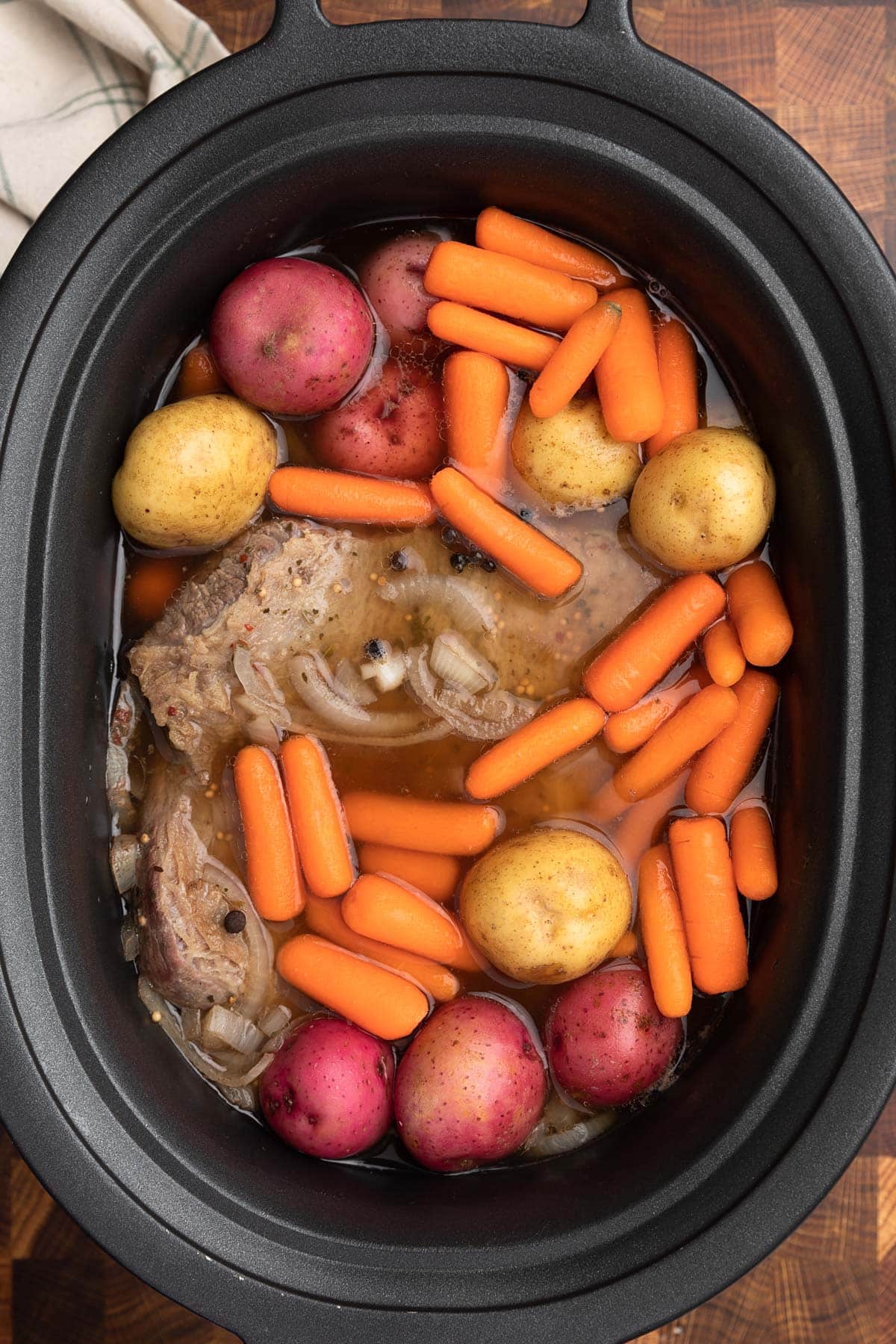
Step 4: Add the Cabbage
Use a medium-sized head of cabbage, cut into 6 to 8 wedges, keeping the core intact to help hold the pieces together. (For a guide, see How to Cut a Head of Cabbage into Wedges from The Spruce Eats.)
Just like the potatoes and carrots, cabbage will become too soft if added to the slow cooker too early. Add it to the slow cooker based on how tender you like it:
- Very soft: Add with 3 hours of cooking time remaining.
- Soft and tender, but still holding together: Add with 2 hours remaining. (This is my family’s favorite.)
- Crisp-tender: Add during the last hour of cooking
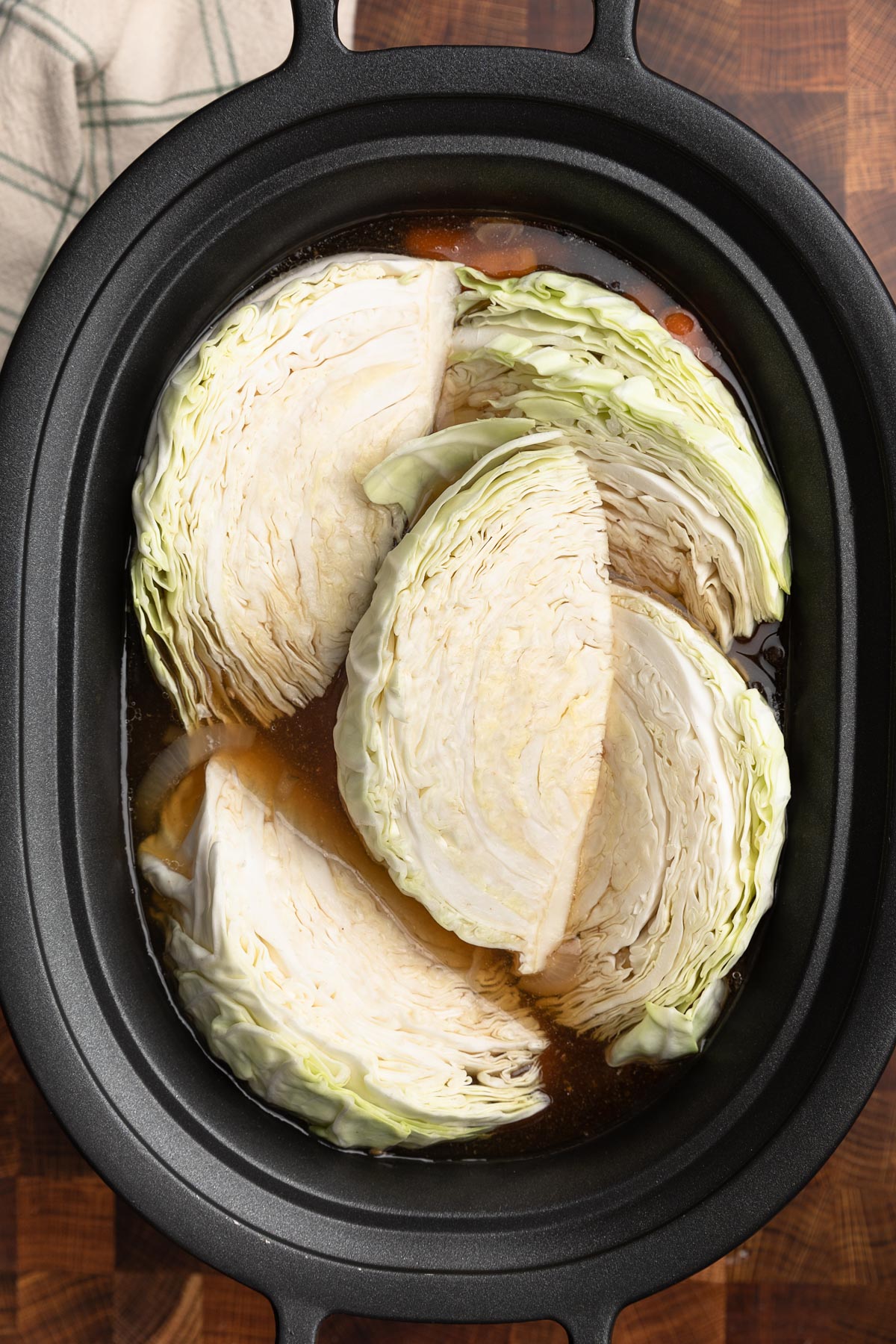
The slow cooker is going to look quite full when you add the cabbage wedges. As long as the lid fits securely, this is fine.
However, depending on the size of your brisket and slow cooker, you may need to adjust the amount of cabbage. (For reference, I could only comfortably fit 5 out of 6 wedges when making the dinner pictured.)
No room for cabbage? Try roasting it instead! My recipe for Roasted Cabbage Wedges creates caramelized, crispy edges that add great flavor to a corned beef dinner.
Or, skip cooking the potatoes and cabbage in the slow cooker altogether and serve the corned beef with a side of Colcannon, a traditional Irish mashed potato dish. This version is made with sautéed cabbage and leeks for a hearty side.

Serving Slow Cooker Corned Beef
Once everything is cooked—and your kitchen smells amazing—it’s time to serve.
- Rest the Meat: Transfer the corned beef to a cutting board, tent it with foil, and let it rest for about 10 minutes before slicing.
- Keep the Vegetables Warm: Remove the cabbage wedges, potatoes, and carrots to a serving platter and tent them with foil.
The vegetables will have great flavor from the cooking liquid, but we like to dress them with a drizzle of melted butter, black pepper, and chopped parsley for garnish. Depending on the saltiness of the cooking liquid, they might need a pinch or two of salt, to taste.
To slice the corned beef, trim the fat cap to your liking (we like to leave some for flavor). Use a sharp carving knife to slice against the grain for tender slices that don’t shred apart. I am for slices about 1/4-inch thick.
I like to strain some of the cooking liquid and drizzle it over the corned beef slices to keep them juicy on the serving platter. Some of our favorite accompaniments for the meal are:
- Mustard. We love whole grain mustard, like Maille Old Style or Lakeshore Wholegrain Mustard with Irish Whiskey {affiliate link}.
- Horseradish Sauce. Try my recipe for Creamy Horseradish Sauce or Roasted Garlic Horseradish Sauce.
- Irish Soda Bread. Slathered with Irish butter, of course!
Storing and Using Leftovers
Leftovers can be stored in an airtight container in the refrigerator for 3 to 4 days. To keep the meat juicy, I like to spoon a little of the strained cooking liquid into the container.
Some my favorite ways to use leftover corned beef are:

Slow Cooker Corned Beef and Cabbage
Ingredients
- 4 to 5-1/2 pound corned beef brisket (I use flat cut), rinsed in cool water
- 1 large yellow onion , halved and cut into 1/4-inch slices
- 4 large garlic cloves , peeled and lightly smashed with the back of a chef's knife
- 1 large dried bay leaf (or two small–see note)
- 2 tablespoons pickling spice (or the seasoning packet that came with your corned beef)
- 8 ounces beer (see note)
- 2-4 cups water
- 1-1/2 to 2 pounds baby potatoes (red or golden, 1-1/2 to 2-inches in diameter)
- 1 pound baby carrots
- 1 medium green cabbage , cut into 6-8 wedges
- melted butter, chopped parsley, salt, and pepper , for garnishing the vegetables (optional)
- whole grain mustard or horseradish sauce , for serving (optional)
Instructions
Cook the Brisket
- Place onions and garlic cloves in the bottom of a 6 to 7 quart slow cooker insert. Sprinkle with half of the seasoning packet or pickling spice. Lay the corned beef over the onions with the fat cap up. Sprinkle the rest of the spice packet over the brisket.
- Pour the beer over the corned beef, followed by enough water to just cover the brisket. Add the bay leaf to the liquid. Put the lid on the slow cooker and set it to LOW heat for 8-10 hours. (The corned beef will be ready when you can slide a fork in and out of the center of the brisket without resistance.)
Add the Potatoes and Carrots
- With 5-6 hours remaining on the total cooking time, add the potatoes and carrots to the slow cooker. Nestle them around the brisket, submerging them in the cooking liquid where possible.
- Replace the lid on the slow cooker and continue cooking on LOW until adding the cabbage.
Add the Cabbage
- With 2 hours remaining, add the cabbage wedges to the slow cooker. (The insert will look full. This is ok as long as you can replace the slow cooker lid snugly.) Cover the slow cooker and continue cooking on LOW for the remaining time.
- (2 hours of cooking on LOW results in fork-tender cabbage. For very soft cabbage, add the wedges to the slow cooker with 3 hours remaining. For crisp-tender cabbage, add the wedges with 1 hour remaining.)
Slice the Corned Beef and Serve
- Remove the cabbage, potatoes, and carrots from the slow cooker. Place them on a serving platter or in a bowl and tent with foil to keep warm.
- Remove the corned beef rom the slow cooker and place on a cutting board. Tent with foil and let rest for 10 minutes. Trim the fat cap, as desired, and slice the meat against the grain into 1/4-inch slices.
- If desired, strain some of the cooking liquid and drizzle it over the corned beef slices on the platter. We like to drizzle the potatoes, carrots, and cabbage with melted butter, season to taste with salt and pepper, and garnish with chopped parsley.
- Serve the corned beef with your favorite mustard or horseradish sauce (recipe links in the notes below).
Notes
Nutrition Estimate
Nutrition information is automatically calculated, so should only be used as an approximation.
About our recipes
Please note that our recipes have been developed using the US Customary measurement system and have not been tested for high altitude/elevation cooking and baking.
Editor’s note: This recipe was originally published on Striped Spatula in February 2023. We have updated the blog post with improved copy to address reader questions we’ve received.















